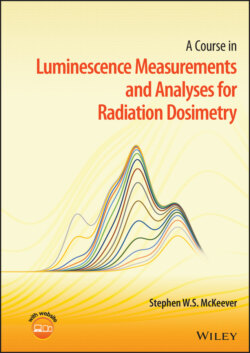Читать книгу A Course in Luminescence Measurements and Analyses for Radiation Dosimetry - Stephen W. S. McKeever - Страница 37
2.2.2 Trapping and Recombination Processes
ОглавлениеOnce an electron-hole pair has been generated by radiation, trapping and recombination processes remove the free charge carriers (electrons in the conduction band and holes in the valence band) from their respective delocalized bands. Several mechanisms can lead to electron or hole capture and recombination. In principle, direct recombination of a free electron with a free hole (i.e. a transition directly across the gap) is possible, but is highly unlikely. Not only would a large amount of energy have to be dissipated, but conservation of momentum requires that the electron and hole recombine with oppositely directed momenta. If the direct recombination process is non-radiative, the energy would have to be dissipated via phonon vibrations. The materials used for radiation dosimetry are wide-band-gap insulators and the band gaps are several electron-volts wide. (For example, in LiF the band gap it is ~14 eV.) Considering that phonon energies in solids are about 0.03 eV at room temperature, thousands of phonons would be needed to couple with the electron in order to dissipate the energy. In contrast, if the energy was dissipated radiatively in the form of photons, the emitted photon wavelengths (using LiF as an example) would be around 80–90 nm, in contrast to the visible wavelengths observed in luminescence measurements. These considerations lead to the conclusion that recombination of charges occurs via localized states in a process known as Shockley-Read-Hall (SRH) recombination. The recombination process leaves the recombination site (defect) in an excited state, radiative relaxation of which produces the luminescence.
Considering only the recombination of free electrons with trapped holes, the rate of SRH recombination can be seen to be dependent on the free electron density, the density of trapped holes, and the temperature. The free carrier lifetime τ of an electron or a hole can be expressed as:
(2.21)
where τtrap and τrecom are trapping and recombination lifetimes respectively, given by:
(2.22)
and
(2.23)
In these expressions v is the free carrier thermal velocity (ve for electrons in the conduction band or vh for holes in the valence band); σ is the relative capture-cross section for either capture by (N−n) empty traps, or for recombination with n trapped charges of opposite sign (free electrons by trapped holes or free holes by trapped electrons) and N and n are the total concentrations of available traps and the concentration of filled traps, respectively. The products A=vσt and B=vσr are the respective trapping/recombination “probabilities” or “transition rates,” in units of m3.s–1.
Capture of electrons or holes at localized states can be via multi-phonon processes, cascade capture, Auger emission or radiative recombination. (See Mott (1978) for an overview and Landsberg (2003) for more detailed treatments.) As argued above, radiative recombination can be neglected for SRH recombination at a level deep within the band gap of a wide-band-gap insulator. Auger emission, either direct or exciton-enhanced, occurs when the energy of the free carrier is transferred to another electron or hole. The process is not often considered in dosimetry materials, but is a possibility to be considered. The temperature dependence of the capture cross-section for the Auger process is usually a power law, σ∝T−a.
In cascade capture, the free charge loses its energy via the successive emission of phonons accompanied by loss of energy of the free charge by cascading down a series of discrete, excited states of the defect, eventually reaching the ground state. For example, a free electron may be captured by cascading down the trapped electron excited states, eventually reaching its ground state. The process requires that the electron will not be re-emitted from any of the excited states back to the conduction band and the probability of this happening will increase with temperature. This leads to a power-law dependence of the capture cross-section on temperature in which the capture cross-section decreases as T increases, σ∝T−a.
The multi-phonon process requires a sufficient number of phonons to allow the defect energy level to cross into the delocalized band and capture the electron (and similarly for hole capture). Phonons are bosons and the distribution of phonons of energy Eph at temperature T is given by Bose-Einstein statistics as 1/(1+ exp{−Eph/kT}). Thus, the availability of sufficiently energetic phonons increases with temperature, giving rise to an exponential dependence of the capture cross-section on temperature (exp{−Eph/kT}). The cascade-capture mechanism is likely to be combined with the multi-phonon mechanism, especially for the last excited-state to ground-state transition. Thus, a combination of a power-law dependence on T and an exponential dependence on T might be expected. Note that if Eph is small, the dependence will approximate to the power law T−a.
Shockley-Read-Hall recombination requires a combination of two of the above capture processes. First, capture of (say) a hole is required, followed by capture of an electron by the trapped hole and consequent electron-hole recombination.
